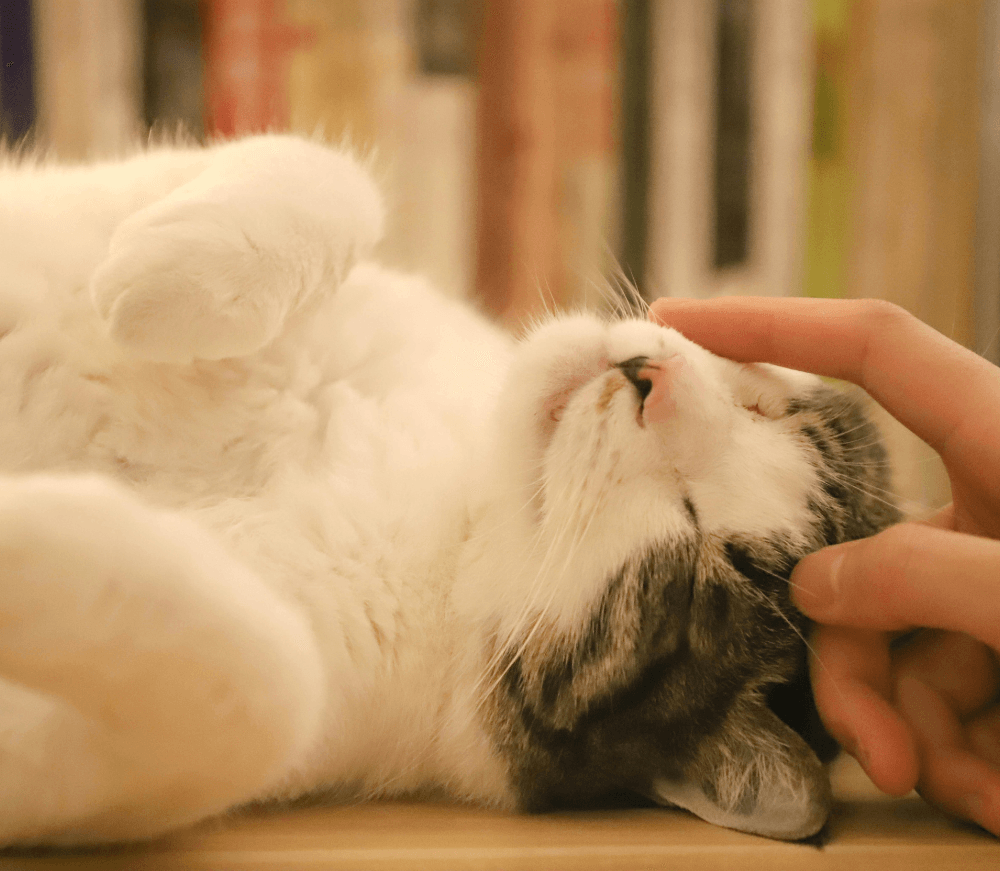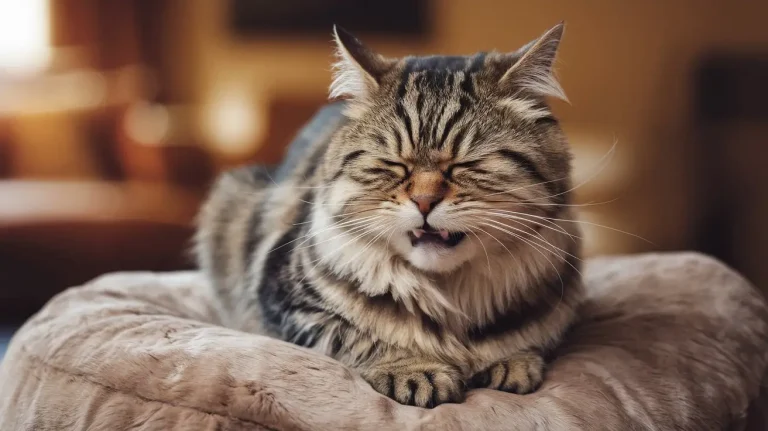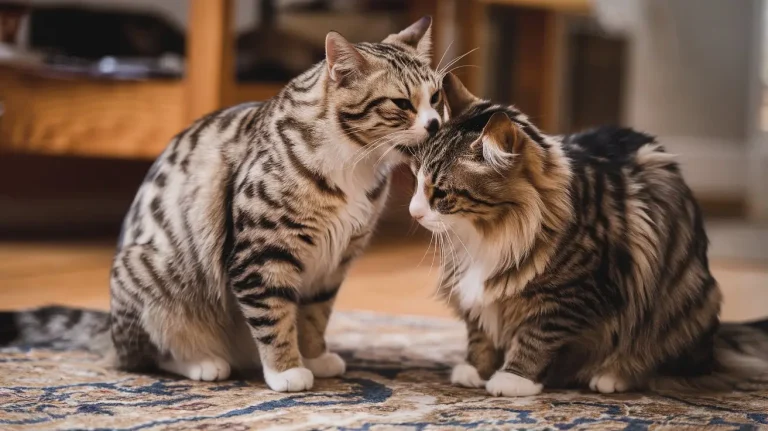When a cat purrs, it is a unique and fascinating behavior that holds both intrinsic meaning for the feline and significance for their human companions. Cat purring is an intriguing aspect of their communication repertoire, offering insights into their emotions and desires.
In this article, we will delve into the world of cat purring, exploring why cats purr, the different sounds they make, and the benefits it brings. By understanding the meaning behind a cat’s purr, we can deepen our bond with these marvelous creatures and enhance our ability to care for them.
So, let’s embark on this journey of discovery to unravel the secrets behind the soothing rumble of a purring cat.
Table of Contents
Key Takeaways:
- Cat purring holds important meaning for both cats and their human companions.
- Purring is a form of communication that reveals a cat’s emotional state and desires.
- Understanding why cats purr can strengthen the bond between cat and owner.
- Cat purring has various benefits, including reducing stress and promoting healing.
- The vibrations produced by a purring cat can have positive effects on human health.
Understanding Cat Purring Behavior
When it comes to understanding the behavior of domestic cats, purring is a fascinating aspect that deserves closer examination. Cats purr in various situations, each with its own unique significance. By observing their purring behavior, we can gain valuable insights into their emotional state and communication.
Contentment: Domestic cats often purr when they are content and relaxed. It is their way of expressing happiness and satisfaction. Whether they are lounging in a comfortable spot or enjoying the company of their human companions, purring serves as a reassuring sign that all is well.
Attention-Seeking: In some instances, cats purr to get attention from their owners. This behavior serves as a subtle invitation for interaction and affection. By vocalizing their purring, cats effectively communicate their desire for engagement and companionship.
Stressful Situations: Surprisingly, cats also purr in stressful situations. It may seem counterintuitive, but purring can serve as a self-soothing mechanism for cats during times of anxiety or discomfort. It helps them relax and cope with challenging circumstances, such as visits to the veterinarian or experiencing unfamiliar surroundings.
Cat purring behavior
It is important to note that cat purring behavior can vary from one individual to another. Some cats may purr more frequently while others may purr less often. The context in which the purring occurs is also crucial in understanding its meaning.
To further explore the behavior of cat purring, let’s take a look at the following table:
| Situation | Behavior |
|---|---|
| Contentment | Purring while relaxed and content |
| Attention-Seeking | Purring to get the owner’s attention |
| Stressful Situations | Purring as a self-soothing mechanism |
The Sounds of Cat Purring
When a cat purrs, it is not just a simple sound. Cats have a repertoire of different purring sounds, each with its own unique meaning and purpose. These variations in purring sounds can provide valuable insights into a cat’s emotional state and even their overall health.
One of the most common purring sounds is a soft, gentle rumble that can be comforting and soothing to both cats and humans. This purring sound often indicates contentment and relaxation. It is a sign that the cat is feeling safe and secure in its environment.
“The gentle purring sound is like music to my ears. It’s a reassuring sign that my cat is happy and at ease.” – Cat owner
However, not all purring sounds are created equal. Cats can also produce louder, more intense purring sounds that may signify a different emotional state. These louder purring sounds can sometimes indicate excitement, anticipation, or even anxiety. It is important to pay attention to the context in which these sounds occur to better understand the cat’s emotional state.
Purring sounds can also vary in pitch and frequency. Some cats have a high-pitched purr that sounds almost like a chirp, while others have a deep and resonant purr. These variations in purring sounds can be influenced by factors such as the cat’s breed, size, and individual characteristics.
A change in a cat’s purring sound could also be an indication of their health. For example, a cat experiencing pain or discomfort may emit a purring sound that is different from their usual purr. It may be more strained or irregular, signaling that something is amiss.
To better understand the different sounds of cat purring, refer to the table below:
| Purring Sound | Meaning |
|---|---|
| Soft, gentle rumble | Contentment and relaxation |
| Loud and intense purr | Excitement or anxiety |
| High-pitched chirp-like purr | Exuberance or happiness |
| Deep and resonant purr | Strong sense of comfort and security |
| Strained or irregular purr | Possible pain or discomfort |
By paying attention to the different sounds of cat purring, owners and enthusiasts can gain a deeper understanding of their feline companions. It allows us to better interpret their emotions and provide the appropriate care and attention they need.
Why Do Cats Purr?
When it comes to cat behavior, one of the most intriguing and enchanting habits is purring. But why do cats purr? Unraveling the mystery behind this humble feline sound reveals both physiological and emotional reasons behind this unique behavior.
Physiological aspect: Purring is a result of a cat’s laryngeal muscles vibrating rapidly, causing the vocal cords to open and close. This vibration can occur both when a cat inhales and exhales, creating a continuous purring sound. Interestingly, cats have been found to purr at a frequency of 25 to 150 Hertz, a range known to have therapeutic effects on bone and tissue healing in humans.
“Cats have a unique ability to produce this healing frequency through their purring.”
This healing aspect of purring has sparked interest in the medical community, leading to research on how cat purring can potentially aid in the treatment of certain ailments.
Emotional reasons: While the physiological aspect of purring is fascinating, the emotional reasons are equally important in understanding why cats purr. Purring is often associated with comfort, relaxation, and contentment. Cats may purr as a way to self-soothe and create a sense of calmness, both for themselves and those around them.
Additionally, purring serves as a form of communication for cats. They may purr to indicate their well-being and contentment, signaling to their owners that they are in a relaxed and peaceful state. Purring can also be a way for cats to seek attention or express their desire for companionship, as they often purr when being petted or cuddled.
Furthermore, research suggests that purring can serve as a communication tool between mother cats and their kittens. Young kittens are born blind and deaf, making it challenging for them to communicate with their mother. However, the vibrations produced by purring can provide a tactile cue, helping kittens locate their mother and ensuring their safety.

The Emotional Benefits of Cat Purring
The emotional benefits of cat purring extend beyond the feline realm. As a cat purrs, the gentle vibrations emitted can have a soothing effect on humans as well. The rhythmic sound and vibrations created by a purring cat can promote feelings of calmness, reduce stress, and even lower blood pressure.
Studies have shown that interacting with a purring cat can release endorphins in humans, producing a sense of happiness and well-being. The therapeutic nature of cat purring has led to the use of therapy cats in various settings, such as hospitals and nursing homes, where their presence and purring provide comfort and emotional support to patients and residents.
| Purring Benefits for Cats | Purring Benefits for Humans |
|---|---|
| RelaxationStress reliefSelf-soothing | Lower blood pressureReduce anxietyProvide emotional comfort |
| Communication with kittensBonding with humansExpressing contentment | Boost happinessEnhance well-beingSupport therapy treatments |
As we delve into the reasons behind why cats purr, we gain a deeper appreciation for this beautiful and complex behavior. Purring serves not only as a means of communication, but also as a source of comfort and healing for both cats and humans. Understanding the multifaceted nature of cat purring allows us to nurture our relationship with these remarkable creatures.
The Benefits of Cat Purring
When a cat purrs, it not only brings comfort and joy to their human companions but also provides several health benefits. The soothing vibrations of a purring cat have been known to have a calming effect on both cats and humans, reducing stress and promoting relaxation.
Research has shown that the frequency of a cat’s purring, which typically ranges between 25 and 150 Hertz, is within the range known to promote tissue healing and regeneration. The vibrations generated by purring can stimulate bone growth, reduce pain and inflammation, and even improve joint mobility in both cats and humans.
Furthermore, the act of petting a purring cat has been found to release endorphins, which are natural “feel-good” chemicals in the brain. This not only elevates the mood of the person petting the cat but also promotes a sense of well-being and contentment.
“The rhythmic sound of a cat purring is like a meditative mantra that helps calm the mind and reduce anxiety. It’s a therapeutic experience that can provide emotional comfort and relaxation,” says Dr. Sarah Thompson, a veterinarian at Pawsome Veterinary Clinic.
In addition to the physical and emotional benefits, cat purring also plays a crucial role in strengthening the bond between cats and their owners. When a cat purrs, it is often a sign of trust and contentment, indicating that they feel safe and secure in their environment.
Moreover, the act of petting and interacting with a purring cat can create a sense of companionship and mutual affection. This shared experience not only deepens the bond between humans and cats but also promotes a sense of responsibility and empathy towards these furry companions.
| Benefits of Cat Purring |
|---|
| Calming effect |
| Reduces stress |
| Promotes healing and tissue regeneration |
| Relieves pain and inflammation |
| Improves joint mobility |
| Enhances mood and well-being |
| Strengthens the bond between cats and humans |
Next, we’ll explore the positive impact of cat purring on human health and how it can provide emotional support and comfort. Understanding the significance of cat purring can deepen our appreciation for these remarkable creatures and the benefits they bring to our lives.
Cat Purring and Human Health
When a cat purrs, it’s not just a delightful sound to our ears, but it also has numerous benefits for human health. The soothing vibrations produced by a purring cat can have a positive impact on our well-being, both physically and emotionally.
One of the notable health benefits of cat purring is its ability to lower blood pressure. Research has shown that the rhythmic purring sound can help reduce hypertension and promote cardiovascular health. So, the next time you feel stressed or anxious, spending time with a purring feline friend might be just what you need to relax and unwind.
Advantage of cat purring
Another advantage of cat purring is its potential to reduce anxiety. The gentle vibrations and comforting sounds emitted by a purring cat can create a calming effect on our nervous system. This makes it an excellent natural remedy for those experiencing anxiety or even insomnia.
Furthermore, cat purring provides emotional comfort to humans. The act of petting a cat and feeling their purring has been known to release endorphins, often referred to as “feel-good” hormones. These endorphins can uplift our mood, provide a sense of relaxation, and even alleviate feelings of loneliness or sadness.
The power of a cat’s purr should not be underestimated. By understanding and harnessing the benefits of cat purring, we can improve our overall well-being and strengthen the bond between humans and their feline companions.
Cat Purring and Communication
When cats purr, it’s not just a simple vibration. It’s a powerful form of communication that helps them express a range of emotions and needs. Understanding this unique aspect of feline behavior can deepen our connection with our furry friends.
Cat purring behavior can have various meanings depending on the situation. One common interpretation is that a cat purring indicates contentment and relaxation. It’s their way of telling us that they feel safe and comfortable in their environment. Purring can also serve as a form of self-soothing, helping cats calm themselves in stressful situations.
“Purring is a way for cats to communicate with humans. It’s their little way of saying ‘I’m happy and content in your presence.'” – Dr. Emily Johnson, Feline Behavior Specialist
Aside from contentment, cats may also purr to seek attention or communicate their needs. They might approach their humans, purring softly, as a way of saying, “I want your attention” or “I’m feeling lonely.” It’s their subtle way of initiating interaction and strengthening the bond with their human companions.
Interestingly, purring is not always a sign of happiness. Cats may also purr when they are in pain or distress. This can be confusing for cat owners as it goes against the conventional understanding of purring as a positive behavior. However, it’s believed that purring in these situations serves as a self-soothing mechanism, helping cats comfort themselves and cope with discomfort.
The Power of Purring
Understanding cat purring behavior is essential for building a strong connection with your feline companion. By paying attention to their purring patterns and body language, you can better respond to their needs and emotions. Whether it’s providing comfort, offering attention, or seeking professional help if they are in pain, responding appropriately to their purring can significantly enhance your relationship.
Next, we’ll explore the different sounds of cat purring and how they can provide insights into a cat’s emotional state and well-being.
Conclusion
In conclusion, the act of cat purring is a fascinating behavior that holds multiple meanings and benefits for both felines and humans. Understanding why cats purr, the sounds they make, and the benefits it brings allows us to deepen our connection with these wonderful creatures.
When cats purr, it signifies more than just contentment. It is a form of communication that expresses various emotions and needs. It can signal relaxation, happiness, and even serve as a means of seeking attention or expressing pain.
Not only does cat purring benefit the cats themselves, but it also has positive effects on human health. The soothing vibrations of a purring cat have been known to lower blood pressure, reduce anxiety, and provide emotional comfort. Cat purring has the power to promote healing and strengthen the bond between cats and their owners.
Embracing the significance of cat purring allows us to fully appreciate the intricate world of feline behavior. By fostering an understanding and respect for their communication, we can foster a harmonious and enriching relationship with our feline companions.
FAQ
What does a cat purring mean?
Is generally a sign of contentment and relaxation. It can also indicate that a cat is seeking attention or is in a stressful situation.
How do cats behave when they purr?
Cats purr in various situations, such as when they are happy, comfortable, or seeking attention. They may also purr when they are in pain or feeling stressed.
What sounds do cats make when they purr?
Cats can make a range of sounds when purring, including a soft vibrating hum, a louder rumble, or a high-pitched trill. The sounds can vary depending on the cat’s emotional state or health.
Why do cats purr?
Cats purr for both physiological and emotional reasons. Physiologically, purring is produced by the rapid contraction and relaxation of the cat’s laryngeal muscles. Emotionally, cats purr to express comfort, relaxation, and communication with their owners and other cats.
What are the benefits of cat purring?
Cat purring has several benefits. It can have a calming effect on both cats and their human companions, reduce stress, and even promote healing. Purring also helps strengthen the bond between cats and their owners.
How does cat purring impact human health?
The soothing vibrations of a purring cat can have a positive impact on human health by lowering blood pressure, reducing anxiety, and providing emotional comfort. Interacting with a purring cat has been shown to improve overall well-being.
How do cats use purring as a mode of communication?
Cats use purring as a way to communicate various messages. They purr to indicate contentment, request attention, or express pain. Understanding the different meanings behind purring can deepen our connection with cats and help us respond to their needs.
Conclusion
Cat purring is a fascinating behavior that holds multiple meanings and benefits for cats and humans alike. By understanding why cats purr, the sounds they make, and the benefits it brings, we can appreciate and nurture our bond with these wonderful creatures.






